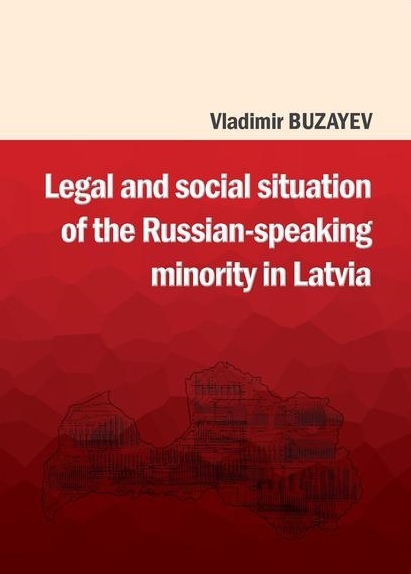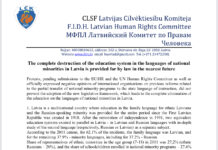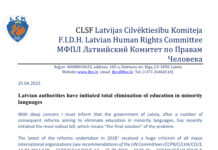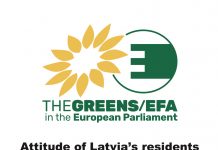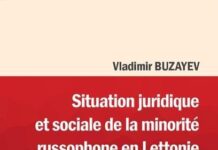Vladimir Buzayev, 2013, Legal and social situation of the Russian – speaking minority in Latvia
Introduction
This book is an outcome of monitoring the position of Latvian national minorities conducted by the Latvian Human Rights Committee since its foundation in December 1992. Its five chapters deal with problems in demography, language policy, education, culture and citizenship, economy.
The research is based on the previous monographs on the situation of national minorities in Latvia, where Vladimir Buzayev was either the author or a co-author. Besides containing latest results, the book for the first time brings under one cover earlier conclusions of the author. It also integrates the data of other research into the issue. The major events concerning the rights of national minorities as well as all the statistic data, including 84 tables and 43 diagrams, are updated as of 2013. In order to provide the most objective vision of today’s Latvia, the author uses information from a wide range of historical and international sources.
The chapter “Comparative Demographics” shows that for the last twenty years Latvia has been the world champion in population reduction; even the fact that the massive economic emigration revealed by the last population census was not taken into account does not change this leadership position. The population size of Latvia dropped from 2.7 to 2 million people, i.e. down to the level of 1900. The chapter also shows the dynamics of the number of Latvians living abroad; the estimation is based on the number of Latvian children born outside the country: it increased from 166 thousand in 2009 to 295 thousand in 2012.
This unprecedented result was achieved due to the policy of “extruding” national minorities from the country; their relative outflow exceeds that of ethnic Latvians five times, even though the latter are also leaving the country en masse.
The relative decrease in national minority population is 2.5 times higher than the relative loss of the USSR in the Second World War; emigration is one major cause for this, another is the significant difference between the birth rate and the death rate, which exceeds the similar ratio of ethnic Latvian population three times. It is proved that the above mentioned difference, which was minimal at the time of the USSR collapse, cannot be attributed to any natural causes but is clear evidence of ethnic inequality. International comparisons show that the rate of natural decrease in Latvian national minority population is second to none in the world.
The author uses the data of the last three censuses in order to analyze the changes in the age composition of ethnic Latvians and non-Latvians. The steady population increase of the USSR was replaced by steady decrease after its collapse due to mass emigration of employable-age population.
The book analyzes the situation of all the 7 largest officially registered national groups of Latvia. The research also includes Latgalians, who are not registered as an ethnic group, even though they are the second largest ethnicity after Russians in Latgale and the third largest within the country.
The comparative demographic data on the three Baltic States do not confirm the statement of the pushy official propaganda that “the USSR government deliberately flooded Latvia with hundreds of thousands of migrants in order to destroy the identity of the Latvian nation”. On the contrary, these data serve as evidence of careful control of natural demographic pressure from those USSR regions, which had the highest birth rates. The unreasonably forgotten data of the last Soviet population census of 1989, which were only published in 1992, helped the author to restore the portrait of the “migrants”: those people were better educated than the local population and were employed in the most vital and labour-intensive industries, besides, most of them lived in hostels and shared apartments and were hardly any burden for the social services.
The chapter “Monolingualism in the bilingual country” describes the evolution of the language legislation and the actual use of languages in present-day Latvia; it includes comparative data of the last century. It also shows the language differentiation in the pre-war Latvia and the achievements of the Latvian SSR in teaching the Latvian language to national minorities. Smaller national minorities are being assimilated into the Latvian and Russian language environments; this process is sharply accelerating in today’s Latvia and seems to be close to accomplishment. The book provides systematic analysis of the data on restriction of national minorities’ language rights in the 1990s.
Special attention is drawn to the modern issues of language assessment of adults and schoolchildren within the context of rule-making at the level of the Cabinet of Ministers that is introduction of language regulations into the private business sphere and language experiments within the basic and high education standards. The author also uncovered and analyzed the results of the centralized high school exam on the Latvian language of 2012, which the State was trying to hide; that was the year when the requirements were unified, which means that they were the same for all the school leavers, both native- and non-native-speakers. The actual data analyzed by the author prove that the introduction of the Latvian language into Russian schools as the language of tuition, which has no precedent in the pre-war Republic, does not lead to any improvement in the language acquisition, which had been declared as the purpose of the “reform” and which was supposed to result in better competitiveness of Russian pupils.
The book also includes research into the activities of the State Language Centre, which enjoyed the second “Renaissance” in 2011 – 2013 in terms of language whistleblowing and language inspections. It is proved that the present methods of language inspections do not differ from those which have already been condemned in the rulings of the European Court of Human Rights and the United Nations Human Rights Committee. Some examples are given of the Latvian Human Rights Committee successful appeals against the actions of the State Language Centre.
The chapter “Cultural and Educational Space” concentrates on research into legislative restrictions and the actual state of education in the Russian language from kindergartens to universities. It provides statistic data on abolition of Russian and bilingual schools throughout the country and also in different regions (including Riga and other major cities as well as the countryside), which clearly show that this process is not caused by any economic necessity. The actual deprivation of the opportunity to get education in the Russian language anywhere outside the major cities (except Latgale), which took place after Latvia ratified the Framework Convention for the Protection of National Minorities, contravenes the country’s international obligations. The latest statistic data show outrunning growth in the number of Russian school starters, which proves that more and more parents choose Russian schools for their children.
The book provides data on sport and culture which show that most achievements in these fields fall on the periods when Latvia was part of the Russian Empire and later of the USSR. The comparative analysis of book publishing demonstrates that the priority of the titular nation was observed in the Soviet Latvian Republic. However, in today’s Latvia it is just overwhelming, beyond any comparison with the pre-war Republic of Latvia.
The book also describes the official version of the historic events which took place between 1940 and 1991 and the methods used to defend this version. Special emphasis is on March 16, Legionnaires’ Day and May 9, Victory Day.
The chapter “Mass Statelessness” describes the evolution of the citizenship legislation and provides the relevant statistics including the list of the 80 differences in the rights of citizens and non-citizens, which are still in force. Incidentally, Latvia is ahead of all the EU countries in terms of stateless population. Together with the non-citizens of Estonia they make up 92% of all the stateless persons among the 500-million population of the EU. Although the number of Latvian non-citizens went down 2.5 times in comparison with 1996, they still make up 34% of all the national minority population of Latvia and 14% of the total country population. Today the proportion of native-born people among all non-citizens is 41%, but among those who are under 50 years of age it is 74%. The average residence term for those non-citizens who were not born in Latvia but lived there in 2013, was 46 years, which exceeds the total period of independence (1918-1940; 1991-2013) and is twice as long as the existence of the Second Republic of Latvia; however, they are still called immigrants with the persistence that could be much better used elsewhere.
Within the last five years the decrease in the number of non-citizens through their naturalization has not exceeded one fourth of the total decrease figure. The number of applications for naturalization and the number of persons who were granted citizenship was the lowest within all the 18-year history of this procedure. Within the last four years acquisition of Russian citizenship has become more popular than Latvian citizenship.
Today’s rate of decrease in the number of non-citizens makes us suppose that by 2027 there will be about 150 thousand non-citizens living in Latvia, but in 2041 – 75 thousand. Among all the stateless persons living in the EU today just about 36 000 are of non-Latvian or non-Estonian origin.
The chapter “Socioeconomic Situation” estimates the damage inflicted onto the country by destruction of the sectors which were declared to be “not relevant for Latvia”. We consider that it makes up 240 milliard LVL, i.e. almost twentyfold GDP volume of 2010. It is also shown that representatives of the national minorities are largely forced out of the public sector, while they are widely represented in the private sector activities, which require manual labour and low qualifications.
The unemployment level among the national minorities is high disproportionately. This is especially true in regard to the long-term unemployed.
In 2002-2009 average wage of the national minorities’ representatives was higher than that of ethnic Latvians by 8%, and in 2012 their share among the people, who estimate their income below the average level, was higher than that of ethnic Latvians by 6%. About 1/3 of pensioners from among the national minorities’ representatives suffered from limiting rights of non-citizens on obtaining pension for accrued Soviet term of employment, which was acknowledged by the European Court on Human Rights as discriminatory. The book author estimates the damage to their property at the amount of 140 million LVL.
Overall the book materials are supposed for those who wish to carry out reasoned discussion on the conditions of the Latvian national minorities for the purpose of adaptation of the current situation in compliance with international standards in this area.
The author expresses deep gratitude to the Support and Protection of the Compatriots Residing Abroad Rights Foundation, without whose assistance it would be impossible to issue this book. The author shows special appreciation of the Latvian Human Rights Committee colleagues Nataly Elkina, Tatjana Zdanoka, Alexander Kuzmin and Doctor of Historical Sciences Tatjana Feigmane for valuable comments and assistance in the project realization. A special gratitude Author express to Alexander Kuzmin, which has been edited the entire text of the book after it was translated into English, as well as presented Annexes 3 and 4.
The collected material in Annexes shows that the position of international organizations on the situation of Latvian national minorities rather closer to the author’s opinion, than to the opinion of the Government of Latvia.





